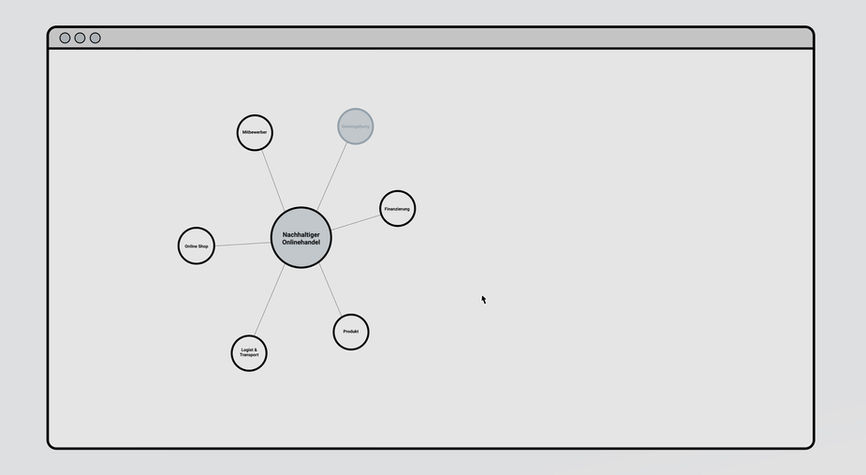Sustainable purchasing decisions in online retail
Every sixth online order in Germany is returned. Returns cause 238,000 tons of CO2 every day (equivalent to around 2,200 car journeys from Hamburg to Moscow) and around 4% of returns end up in the trash.
As part of the methods course "(Almost) everything about UX methods", we are looking at how digital services can be improved so that purchasing decisions are made more confidently and online retail becomes more sustainable and ecological. The realistic representation of product-specific aspects (such as materiality, fit, size and color) in the digital world was just as much a focus of the investigation as user needs and the consideration of existing solutions for logistics and transport.
The aim was to apply and implement the methods learned in the course in our own project.

Project duration: 3.5 months - 2020
Type of project: University project within one semester
Focus: UX design methods, sustainable purchasing decisions, online retail
Tools: Figma (prototyping), Miro (collaboration), Google forms (surveys for research)
Methods: Interviews, Interview script, user journey, surveys, stakeholder map, personas, needs pyramid based on empathy map, wireframes, interactive mockups
Team: Hannah Fischer, Annika Gassebner, Milan Friedrich
Research
Process
As part of the research process, we started by looking at various online stores in general and took a closer look at and analyzed existing forms of product presentation and the ordering process.
The focus was on clothing-specific aspects such as fit, size selection, color, materiality and general information about the item, such as fair production methods and sustainability.
In the further course of the research, we looked at other approaches to article presentation and improving size selection within research and existing startups.
.jpg)
Excerpt from the research on existing online stores as well as the product presentation and the ordering process
We then took a closer look at and evaluated existing approaches within the Miro Board with regard to item display and finding the right dress size.
The illustration on the right shows an evaluation scale from well-functioning, with a double plus (+ +) noted in green, to less functioning approaches, which we positioned in red with a double minus (- -).

Mood board for researching various approaches, clustering according to approaches that work well (green, ++) and approaches that work less well (red, --)
Quantitative - online survey on the topic of online shopping
Using an online survey, we were able to gain an overview of the needs and demand for online retail in the various age and professional groups.
In addition to general questions about the 55 participants, we asked about purchasing behavior and priorities in order to better understand the relationship between return rates, purchase quantities and purchasing decisions.
It also became clear that a price advantage is more important than sustainability for the majority of respondents, that an interest in sustainability does not preclude the return of several items and that mass shoppers almost exclusively stated a return rate of 75-100% despite a high level of experience with their clothing size. The survey helped to gain new insights and confirm or refute hypotheses. The method created a rough overview and provided new findings that were followed up and investigated in future steps.
Excerpts from the online survey with 55 participants
First round of interviews
The guided interview method helped us to collect data on a specific topic. Potential users or users from the target group were systematically interviewed using a guideline in order to get to know and understand both the users and their needs for a system better.
The aim of the research phase, including the interviews, was to interview at least three to four people within the team. After conducting and evaluating the interviews, we quickly noticed a pattern in the people's behavior. We transformed extracts from these interviews into personas.
With the help of the interviews, we identified the following four types or patterns:
-
Customer persona 1: mainly online, cheap, lots of choice
-
Customer persona 2: rare, very selective, picky, only orders from certain stores
-
Store operator persona 1: conscious, sustainable, personal, individual, quality
-
Store operator persona 2: number-driven, modern, trend-conscious, quality is not the main focus
In order to gain an insight into the other side, the seller or store operator side, we devoted ourselves to the expert interviews.
Second round - qualitative expert interviews
In contrast to quantitative interviews, expert interviews are used to collect expert knowledge. With the help of this qualitative form of interviewing, more targeted questions are asked to selected experts in order to build on their basic knowledge and use this knowledge to answer existing questions.
For our project, it was very important to us to obtain the views of store operators and sellers, i.e. the experts, in addition to the quantitative survey of people.
The difficulty in realizing the interviews was that very few people had time for us, especially in times of Corona. So we managed to interview a total of three store owners, more through direct contacts or acquaintances. These included Jan van Essche, Triumph and Kauf dich glücklich.
For the qualitative interviews, we also drew up a list of questions within the team, which this time was intended to provide more insights into individual perspectives on order returns and the current coronavirus situation.
Analysis of the interviews - extraction of potential solutions
As part of the process, we again looked at the expert interviews conducted from the consumer's perspective and clustered the solutions mentioned on the shared Miro board.
This graphic collection shows a differentiation between "feasible solution approaches", which could be implemented 1:1 as functional models, and so-called "wishful thinking", among which more conceptual and speculative approaches can be found. With the help of the "thumb's-up emoticon", we selected approaches within the group that we want to develop further.
.jpg)
Clustering of the solution approaches (from expert interviews) into feasible solution approaches
and ideal solutions
Stakeholder analysis
The previous steps led to new, relevant fields of investigation. The stakeholder analysis depicts the influences of individuals, social groups and institutions in the online textile trade. By identifying these interest groups, processes and interrelationships become comprehensible. The stakeholder map analyzes difficulties in the entire online textile trade and positions interest groups. The map takes into account the perspectives of consumers and store operators in order to identify the main influences and dependencies.
.jpg)
.jpg)
Personas
The development of personas uses a method to act as an archetypal user for the application/service to be developed. Based on interview results, four fictitious personas were created that represent various characteristics of the interviewees and thus symbolize a larger group of people/target group. These personas are divided into store operators and consumers and describe their problems, challenges, motivations, goals and needs in the context of an online fashion store or clothing.
.jpg)
.jpg)
Customer personas, differentiation between selected / infrequent and mainly online / a lot
.jpg)

Store operator personas, differentiation between conscious/sustainable and number-driven/mass-driven
"Pyramid of needs" based on empathymap
Based on interviews with customers and experts, needs were analyzed and presented in a "needs pyramid". The pyramid is divided vertically into categories such as shopping experience, clothing and online store. On the left are the consumers, on the right the store operators, to whom the needs were assigned. The aim was to clearly identify the needs and use them as a guideline for the project and idea generation.

Overview of the "needs pyramid" with the various actors and their needs

Excerpt from the "needs pyramid" - needs for the shopping experience
Ideation concept
During the ideation process, we visualized initial ideas for sustainable online retail. The focus was on the improved presentation of textile products in terms of color, material and fit (using size assistants and avatar presentation) as well as the integration of digital consulting options.
%20(1).jpg)
.jpg)
.jpg)
Toolkit for more sustainability in online retail
In the course of the work process, the focus changed. Originally, it was on the conception of an improved interface design for sustainable online stores. The aim was to promote secure purchasing decisions through detailed product presentations and to achieve greater sustainability in online retail in the long term.
However, the results of the UX methods used showed that this approach was not effective. Customers were interested in sustainability, but changing their behavior alone was not enough. We therefore extended the focus to store operators and developed a toolkit for both target groups.
The toolkit provides an overview of sustainability aspects in online retail. The interactive dashboard provides information and concrete suggestions for more sustainability for consumers and store operators. The prototype focuses on the toolkit for store operators, with guidelines for improved interface design and a category system for assessing sustainability efforts. The system can be used as a guide or seal in the online store to make sustainability efforts transparent to customers.
Preview of the interactive prototype with a focus on store operators with information and concrete suggestions for more sustainability














